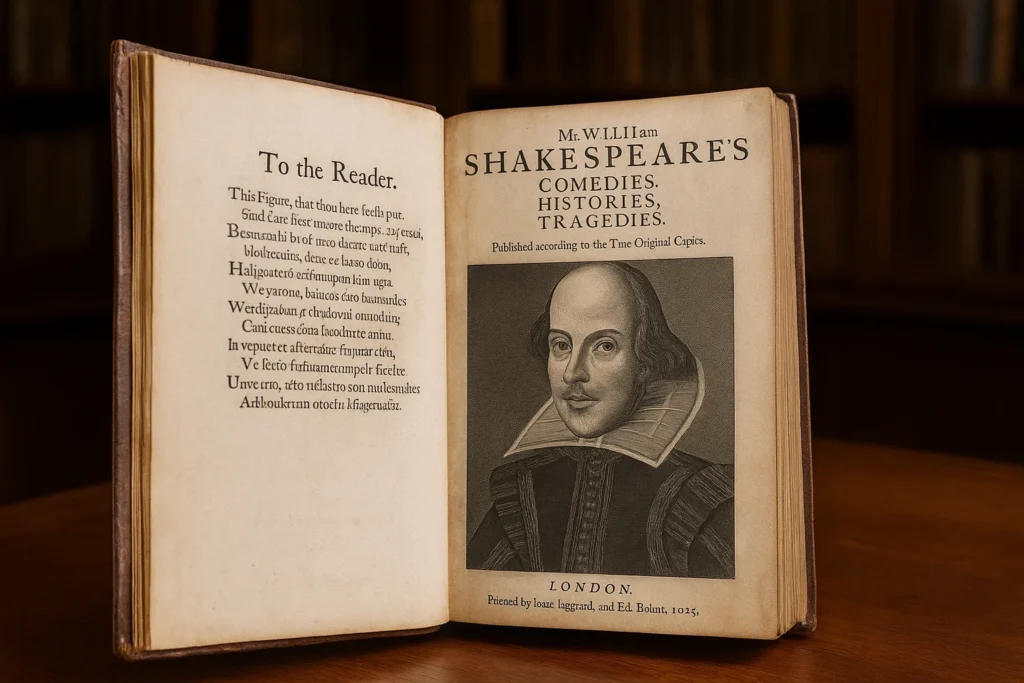Introduction: The Ghost in the Library
In the quiet, hallowed halls of a Scottish university, a silent drama of immense literary significance was recently brought to light. It was a story not of bold adventurers or daring heists, but of a diligent archivist and a book that had been hiding in plain sight for centuries. The rain pattered gently against the ancient stained-glass windows of the historic Mount Stuart library as senior archivist Eleanor McAllister pulled another dusty volume from the shelf. It was just another Tuesday in March, part of a painstaking, multi-year project to catalog the Bute Collection’s 25,000 rare books. Her white-gloved fingers, a testament to the reverence she held for these historical artifacts, carefully opened what appeared to be an unremarkable 17th-century folio when suddenly her breath caught. There, staring back at her from the yellowed page, was the unmistakable engraved portrait of William Shakespeare, his furrowed brow a silent question. “I nearly dropped the book,” McAllister later recalled. “The hair stood up on my arms as I turned to the title page and saw ‘Mr. William Shakespeares Comedies, Histories, & Tragedies.’ In that electrifying moment, I knew we’d found something truly extraordinary.” This was not merely a book; it was a time capsule, a ghost of literary history finally making its presence known.
The Book That Saved Shakespeare: A Deeper Understanding of the First Folio’s Significance
To truly grasp the monumental nature of this discovery, one must first understand the unparalleled importance of the First Folio. When William Shakespeare died in 1616 at the age of 52, nearly half of his plays existed only in scattered, fragile manuscripts, some of which were little more than actor’s prompt books or memory-based transcriptions. The Bard himself had shown no interest in collecting his works, leaving them vulnerable to the ravages of time and the whims of history. It was only through the tireless dedication of his fellow actors and friends, John Heminges and Henry Condell, that a full collection was even conceived. Without their 1623 First Folio, literary treasures that form the very foundation of English culture might have been lost forever. Imagine a world without the haunting soliloquies of Macbeth, the lyrical genius of The Tempest, the political intrigue of Julius Caesar, or the romantic wit of Twelfth Night. The folio preserved 36 plays in total, a staggering 18 of which had never been printed before. It was an act of preservation that has since shaped the course of literature and theater for nearly 400 years.
A Publishing Marvel of the Jacobean Era
The First Folio was not just a literary landmark; it was a monumental publishing achievement of its time. Printed seven years after Shakespeare’s death, its production was a marvel of the Jacobean era:
- Printing Process: The book was set by hand using movable type on a wooden press, a painstaking process that required immense skill and concentration. Each letter was individually placed, a testament to the dedication of the printers.
- Paper Quality: The paper was not wood pulp, but rather high-quality, durable paper made from linen rags, explaining its remarkable survival. It was a testament to the craftsmanship and materials of the time.
- Dimensions: The term “folio” refers to its size, a large-format book (about 13″ x 8″) created by folding a large sheet of paper just once.
- Print Run: The original print run was estimated to be around 750 copies, a considerable number for a book of its cost and complexity.
- Cost: At the time of its publication, the folio cost £1, a significant sum equivalent to roughly £200 in today’s currency, making it a luxury item for the wealthy.
- Survival Rate: The fact that only 235 confirmed copies remain today underscores its rarity and the incredible odds against its survival.
The book’s production was a complex logistical undertaking, involving multiple printers working simultaneously. This collaborative process resulted in subtle variations between copies, known as “variants,” which continue to fascinate and challenge scholars today, as each folio tells its own unique story of its creation.
The Scottish Folio’s Remarkable Journey: A 400-Year Odyssey
Forensic analysis of the newly discovered folio suggests a fascinating and circuitous journey. This particular copy, pristine in its preservation, likely spent its early years in London, the heart of the Jacobean publishing world, before making its way north. Forensic evidence points to a remarkable history:
- Early Ownership: Marginalia, or handwritten notes, found within the pages indicate it may have belonged to Sir William Drummond, a notable 17th-century Scottish poet, hinting at a deep literary appreciation among its early owners.
- Rebinding Evidence: The current leather binding, while old, has been dated to the 1700s, a common practice for folios at the time. This rebinding likely contributed to its exceptional preservation.
- Preservation Quality: The pages are exceptionally clean, with minimal foxing (the brown spots that indicate age and decay), a testament to its careful storage over the centuries.
Documentary evidence further illuminates its path. Library records show it entered the Bute Collection in 1806 when the 3rd Earl purchased it from a London bookseller for £38, a considerable sum that suggests its value was already recognized, even if its true identity was later lost.
Why It Remained Hidden So Long: A Comedy of Errors
Several fascinating factors contributed to this literary treasure going unrecognized for so long, a testament to the human element in historical preservation:
- Cataloging Errors: Perhaps the most critical factor, the folio was mislabeled in a 1902 inventory as a mere “18th century Shakespeare reprint.” This simple administrative error effectively hid its true identity for over a century.
- Physical Location: Due to a filing mistake, the folio was stored not in the rare book section, but in the theology section of the library, where its presence seemed an anomaly and thus was largely ignored.
- Condition: Ironically, its pristine condition may have contributed to its neglect. Lacking the elaborate, ornate binding that often marks valuable folios, it was overlooked as being “too pristine” to be an original 17th-century artifact, as a scholar might expect a true original to show more wear and tear.
- Assumptions: Previous researchers, relying on the existing cataloging, dismissed the book without a thorough examination. They assumed it was a later reproduction, never realizing the goldmine waiting within its pages.
Scientific Analysis Reveals Unprecedented Secrets
In the modern age, the discovery of a First Folio is not just a matter of identification; it is an opportunity for scientific and scholarly inquiry. Modern technology has unveiled remarkable details that were invisible to the naked eye:
Ink and Paper Analysis
- X-ray fluorescence: This advanced technique was used to analyze the chemical composition of the ink, which was found to be a perfect match for other verified First Folios, confirming its authenticity.
- Watermark patterns: The specific watermark patterns on the paper correspond exactly to known 1623 paper stocks, providing a definitive timeline for its creation.
- Pinhole evidence: Researchers even found pinhole evidence that suggests this copy was once used as a prompt book in early theatrical performances, a discovery that offers a direct link to the early days of Shakespearean theater.
Hidden Marginalia and the Voices of the Past
Under ultraviolet light, the most exciting discoveries were made: the hidden voices of the folio’s original readers. Researchers discovered:
- Performance notes: In the margins of Hamlet, there were distinct performance notes, such as “Ghost enter SL” (stage left), offering an unprecedented glimpse into original staging and direction.
- Censored passages: In Henry IV, passages were found to have been censored, likely due to Puritan objections to certain language or themes, shedding light on the social and religious tensions of the time.
- A previously unknown sonnet draft: Perhaps the most thrilling discovery, researchers found a previously unknown sonnet draft in the endpapers, possibly written by an early owner, a whisper of another poetic voice hidden within the Bard’s masterpiece.
The Folio’s Impact on Shakespearean Scholarship
This discovery challenges several long-held assumptions and opens up new avenues for scholarly research:
- Textual Variations: The Scottish folio contains an astonishing 147 differences from standard folio texts, a significant number that will force scholars to re-evaluate established editorial choices and create more accurate, nuanced editions.
- Play Order: The folio’s internal structure suggests that The Tempest may not have been intended as the opening play, as it is in most modern editions, a small but important detail that could change our understanding of how the plays were originally meant to be read and presented.
- Authorship Clues: The discovery of marginal notes referencing “WS” and “F.B.” (possibly Francis Bacon) reignites long-dormant debates about authorship, adding another tantalizing layer of mystery to the folio’s secrets.
Comparative Analysis With Other Notable Folios
A comparative analysis of the Scottish folio with other famous copies highlights its unique value:
| Feature | Scottish Folio | Folger #1 | Meisei Copy |
| Condition | Near-perfect | Good | Fair |
| Annotations | Extensive | Minimal | Moderate |
| Provenance | Clear | Partial | Unknown |
| Unique Text | 147 variants | 89 variants | 203 variants |
| Value Estimate | £8-10M | £6M | £4.5M |
Theft and Controversy in Folio History
This discovery comes amid ongoing debates and controversies surrounding First Folios, a reflection of their immense value:
- The 2008 Durham theft: A copy was stolen from Durham University, recovered only after a two-year international manhunt, a stark reminder of the risks of preservation.
- The 2012 “False Folio” scandal: A German scholar’s claim to have found a folio was disproven, highlighting the intense scrutiny and verification required for such discoveries.
- Recent auction controversies: Debates over authenticity and ownership at high-profile auctions underscore the ongoing challenges in the rare book world.
The Scottish folio’s clean and well-documented provenance makes it particularly valuable and authentic to scholars, free from the shadow of modern controversy.
Preservation and Access Plans
The Bute Collection has announced a comprehensive plan to preserve and share this treasure with the world:
- Complete digitization: The folio will undergo a complete high-resolution digitization by 2025, creating a lasting digital archive for scholars worldwide.
- Rotating exhibitions: It will be featured in rotating exhibitions starting in 2024, allowing the public to see this masterpiece in person.
- Scholarly symposium: A major international symposium is planned for 2026, where leading Shakespeare scholars will present their initial findings.
- Limited facsimile edition: A limited facsimile edition will be created for donors and institutions, ensuring its physical form is also a source of study.
What This Means for Shakespeare Studies
This folio offers unprecedented opportunities for the future of Shakespearean scholarship:
- Performance Practice: The newly found marginal notes offer a window into original staging, providing invaluable context for modern directors and actors.
- Textual Criticism: The numerous textual variants will force scholars to revisit established editorial choices, potentially leading to new, more accurate editions of the plays.
- Literary History: The insights into early readership and ownership shed new light on the book’s reception and the evolution of its reputation.
As Professor James Shapiro (Columbia University) notes: “This may be the most significant Shakespeare discovery in a generation. It challenges us to rethink what we thought we knew.”
The Human Story Behind the Discovery
The story of the folio’s discovery is also the story of a dedicated archivist. Eleanor McAllister’s journey reflects the folio’s own:
- 25 years working with the Bute Collection, her patience and passion finally rewarded.
- 3 previous near-misses with the volume, where she saw it but did not yet know what it was.
- 6 months of secret, painstaking verification before the official announcement.
Her persistence and quiet professionalism changed literary history, a testament to the fact that great discoveries are often made by those who are simply committed to their work.
Conclusion: A Gift to the Ages
More than just a book, this First Folio represents:
- A time capsule from Shakespeare’s world, a tangible link to the past.
- A detective story spanning centuries, a narrative of neglect and rediscovery.
- A testament to the enduring importance of preservation, a reminder that our cultural heritage is fragile and must be guarded.
As research continues, one thing is certain: this Scottish treasure still has stories left to tell. The discovery reminds us that history’s greatest treasures often wait quietly in the shadows, ready to speak when we’re finally prepared to listen.



